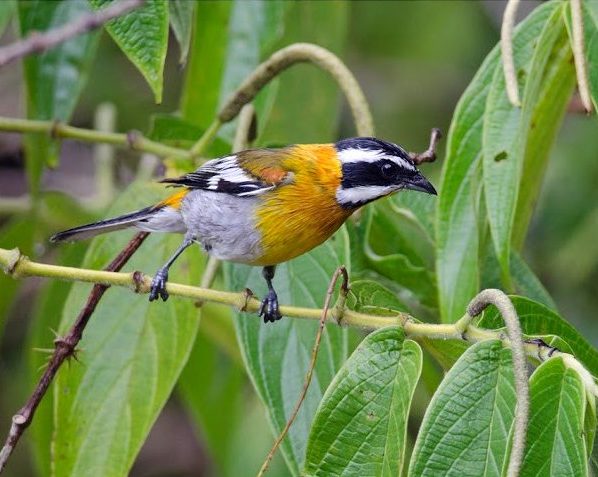Birdfinding.info ⇒ A form of Western Spindalis that is common across most of its range. Especially easy to find at mountain sites such as Viñales, La Güira, and Topes de Collantes National Parks, and the Sierra del Rosario Biosphere Reserve, as well as some of the popular lowland sites, including the Zapata Swamp, Cayo Coco, and nearby islands. Also present at lower densities at most other frequently visited Cuban sites.
“Cuban Spindalis”
Spindalis zena pretrei
Endemic to Cuba and its satellite islands, including Isla de la Juventud and most of the major keys, where it is common at all elevations in a wide variety of wooded and semiopen habitats from coastal scrub to montane forests.
Has been documented at least once as a vagrant in the Florida Keys.
Identification
Male is unique in its range, with its striking black-and-white head pattern, olive back, and yellow-orange nape, rump, and breast.
Does not normally occur with other spindalises, but potentially overlaps with similar forms of Western Spindalis: “Dark-backed” and “Grand Cayman.”
Among these forms, male “Cuban’s” most distinctive feature is the comparative uniformity of the orange coloration on its rump and breast. Although the shade of orange varies from yellowish to brownish, on each individual it is fairly consistent. The other forms have more noticeable gradations and, in particular, a much more pronounced dark bib.
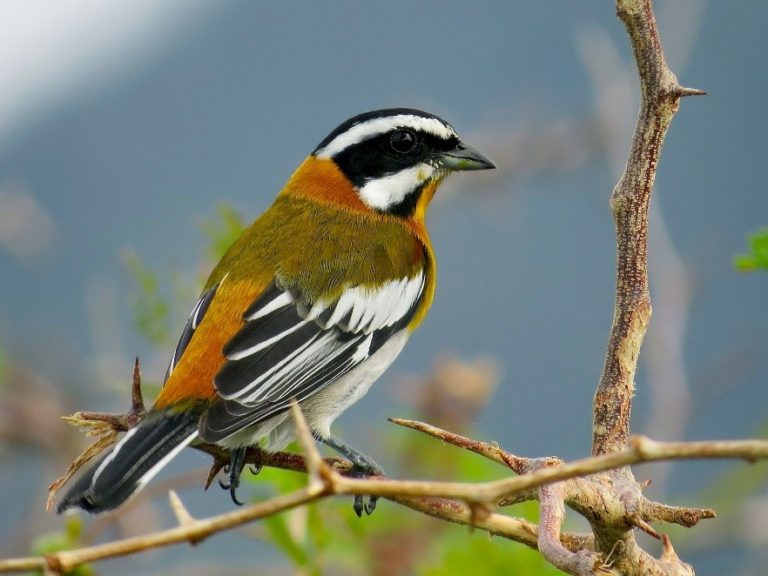
“Cuban Spindalis,” S. z. pretrei, male. (Topes de Collantes National Park, Cuba; January 4, 2016.) © Kenneth Pinnow
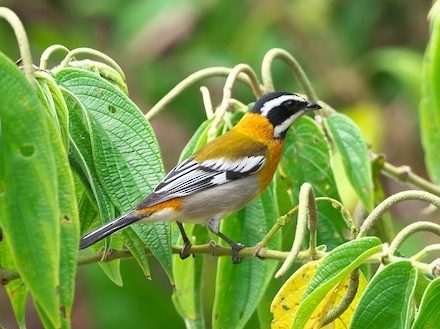
“Cuban Spindalis,” S. z. pretrei, male. (Topes de Collantes National Park, Cuba; February 17, 2017.) © Paul Tavares
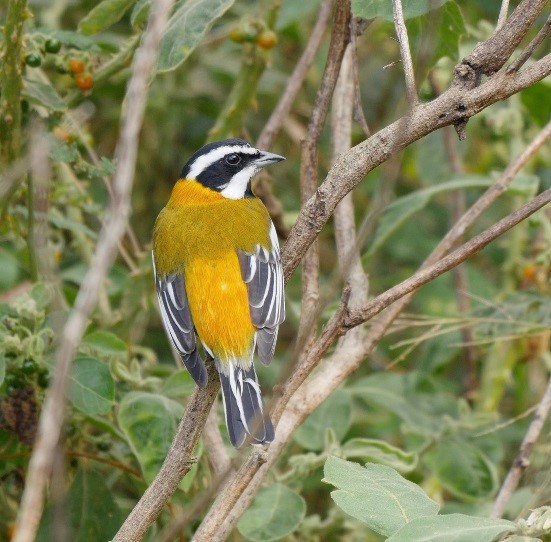
“Cuban Spindalis,” S. z. pretrei, male. (Puerto Esperanza, Pinar del Río, Cuba; January 14, 2017.) © Greg Baker

“Cuban Spindalis,” S. z. pretrei, male. (Soroa, Pinar del Río, Cuba; April 24, 2017.) © Karl-Heinz Dohlich
Female is olive-gray overall, with a vague representation of the male’s distinctive pattern. Compared to females of other forms of Western Spindalis, “Cuban” has more pronounced facial markings and stronger contrast between dark and light tones—especially on the wings.

“Cuban Spindalis,” S. z. pretrei, female. (Cayo Santa María, Cuba; February 22, 2015.) © Josh Vandermeulen

“Cuban Spindalis,” S. z. pretrei, immature. (Playa Larga, Matanzas, Cuba; December 6, 2016.) © NigelJE
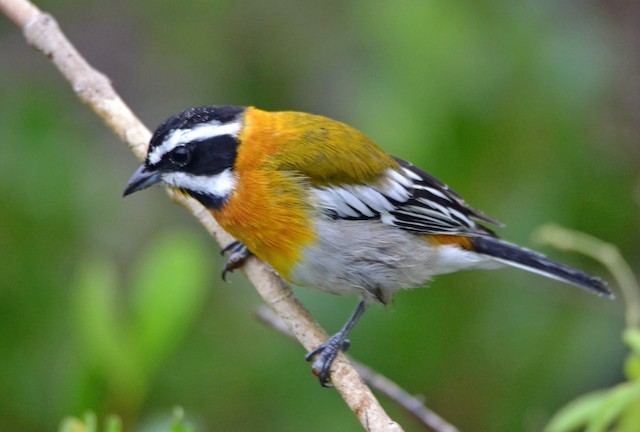
“Cuban Spindalis,” S. z. pretrei, male. (Cueva de Jabali, Cayo Coco, Ciego de Ávila, Cuba; November 11, 2017.) © Michael J. Good

“Cuban Spindalis,” S. z. pretrei, male. (El Pinar, Pinar del Río, Cuba; April 15, 2017.) © Daniele Mitchell

“Cuban Spindalis,” S. z. pretrei, male. (Viñales Valley, Pinar del Río, Cuba; February 11, 2015.) © Josh Vandermeulen

“Cuban Spindalis,” S. z. pretrei, male. (Cayo Coco, Ciego de Ávila, Cuba; April 6, 2007.) © Momma Horton
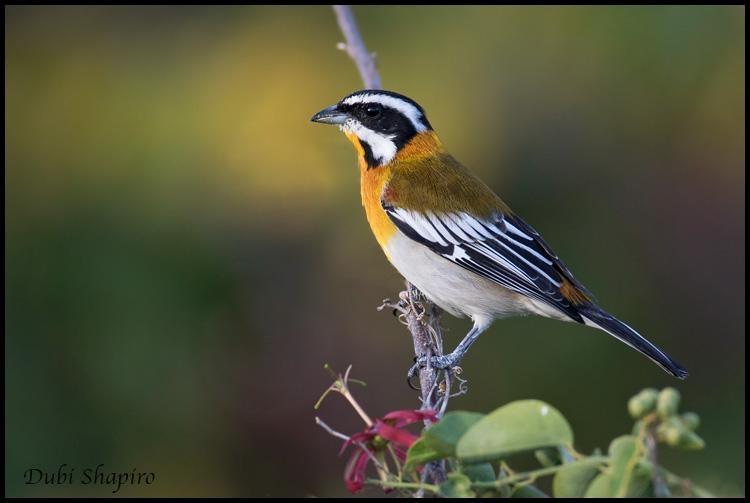
“Cuban Spindalis,” S. z. pretrei, male. (Cayo Guillermo, Ciego de Ávila, Cuba; December 6, 2014.) © Dubi Shapiro

“Cuban Spindalis,” S. z. pretrei, male. (Viñales, Pinar del Río, Cuba; January 10, 2017.) © Anders Dahl

“Cuban Spindalis,” S. z. pretrei, female. (Cayo Coco, Ciego de Ávila, Cuba; March 26, 2013.) © Grace Oliver

“Cuban Spindalis,” S. z. pretrei, female. (Turquino National Park, Cuba; March 30, 2017.) © John Lloyd
Notes
Monotypic form, one of five potentially distinct forms of Western Spindalis.
Distinguishable from other forms of Western Spindalis based on voice and coloration. “Grand Cayman Spindalis” is clearly a close relative, and it is possible that these two could be considered a single species separate from the other forms of Western Spindalis.
All spindalises were formerly considered to be a single species, the Stripe-headed Tanager, S. zena.
References
eBird. 2018. eBird: An online database of bird distribution and abundance. Cornell Lab of Ornithology, Ithaca, N.Y. http://www.ebird.org. (Accessed December 10, 2018.)
Garrido, O.H, and A. Kirkconnell. 2000. Field Guide to the Birds of Cuba. Cornell University Press, Ithaca, N.Y.
Hilty, S. 2018. Western Spindalis (Spindalis zena). In Handbook of the Birds of the World Alive (J. del Hoyo, A. Elliott, J. Sargatal, D.A. Christie, and E. de Juana, eds.). Lynx Edicions, Barcelona. https://www.hbw.com/node/61832. (Accessed December 5, 2018.)
Howell, S.N.G., I. Lewington, and W. Russell. 2014. Rare Birds of North America. Princeton University Press, Princeton, N.J.
Raffaele, H., J. Wiley, O. Garrido, A. Keith, and J. Raffaele. 1998. A Guide to the Birds of the West Indies. Princeton University Press, Princeton, N.J.
